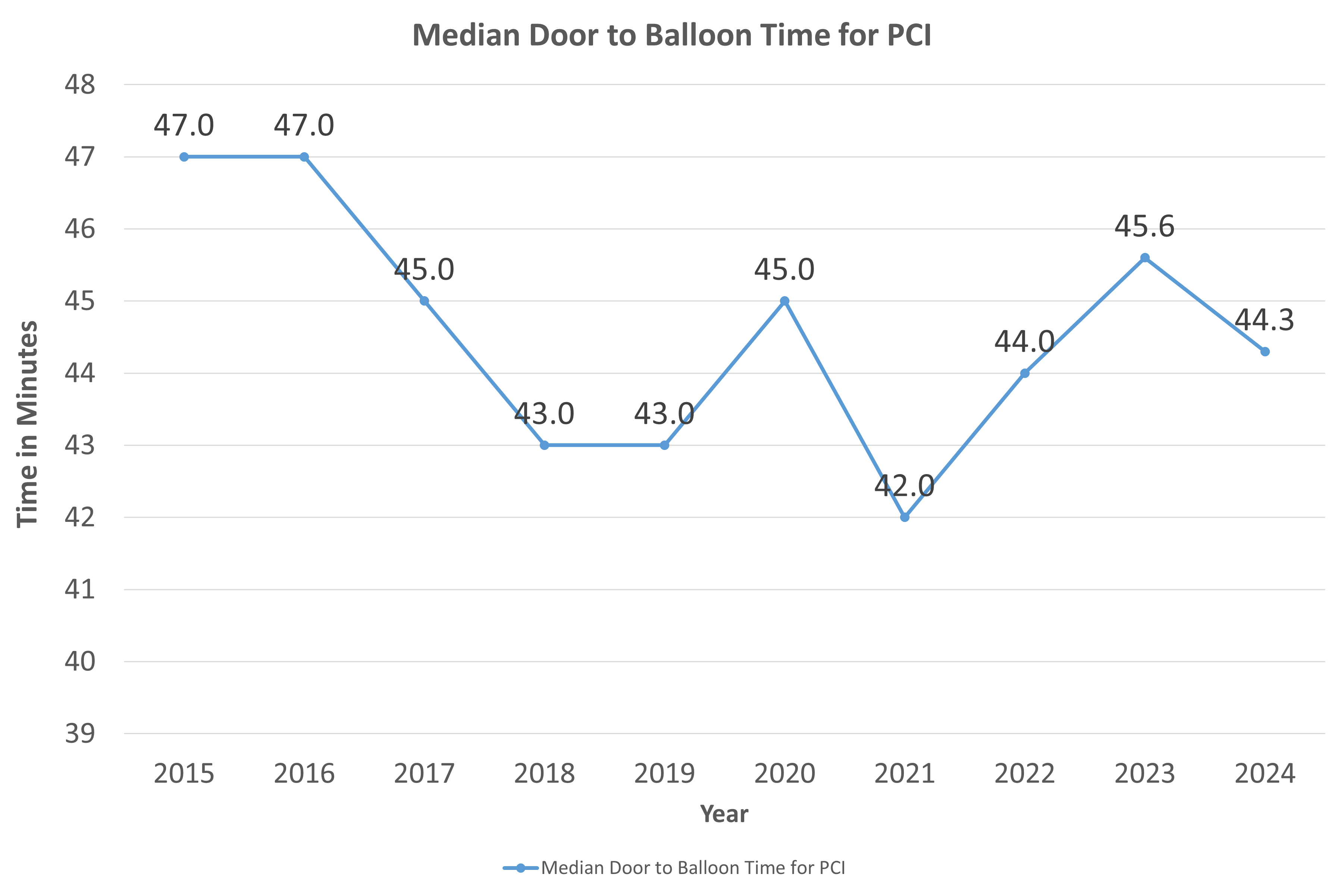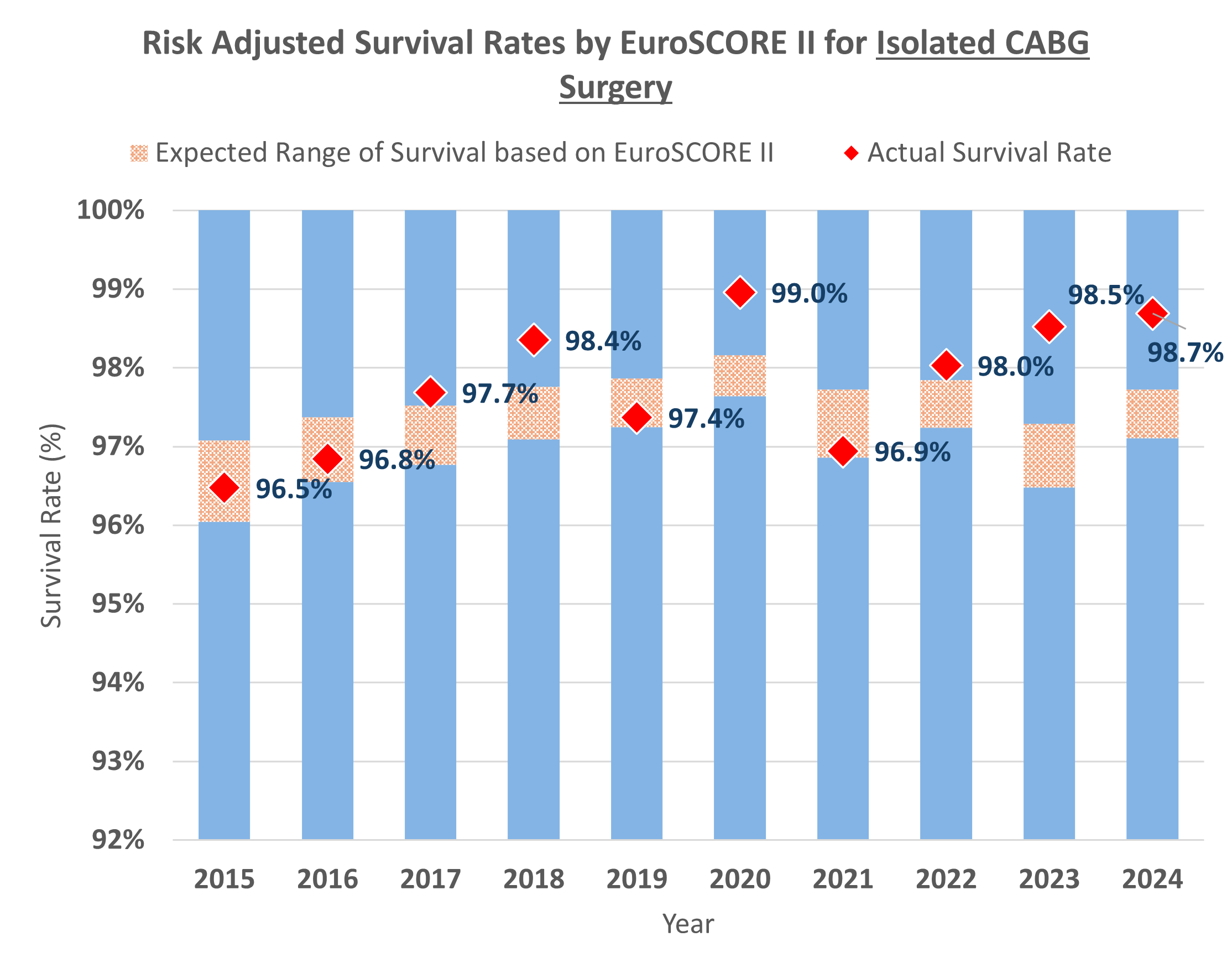NUHS Institutions will NEVER ask you to transfer money or disclose bank details over a call.
If in doubt, call the 24/7 ScamShield helpline at 1799, or visit the ScamShield website at www.scamshield.gov.sg.
Door-to-balloon time measures how long it takes before a heart attack patient receives primary percutaneous coronary intervention (PCI) or balloon angioplasty upon entering the door of the hospital.
It is an important quality measure as reducing door-to-balloon time saves time and lives. At present, the international standards developed by the American College of Cardiology (ACC) and the American Heart Association (AHA) states that hospitals should achieve a door-to-balloon time of 90 minutes or less.
From 2015 to 2024, NUHCS' Percutaneous Coronary Intervention (PCI): Median door-to-balloon time for patients had decreased significantly. Our median door-to-balloon time is calculated in minutes, either starting from the patient's arrival at the hospital to PCI in patients with ST elevation or Left bundle branch block (LBBB) on ECG performed closest to hospital arrival time.

A variety of heart operations are performed by the cardiothoracic surgeons in the National University Heart Centre, Singapore (NUHCS).
This site provides an overview of the volume and types of common adult heart operations and clinical outcomes of the patient population who underwent heart surgery at the National University Hospital (NUH) from 2009 until 2022.
Type of heart surgery performed includes but not limited to:
Survival after heart surgery is defined as "no deaths within 30 days of surgery or within the same hospital admission (as the heart surgery)".
Survival rate = (Number of patients who survive a heart surgery per year / Total number of patients underwent a heart surgery per year) x 100%

The actual survival rates slipped back in 2015 and 2016 due to a surge in higher risk heart surgeries. This outcome reflects our unwavering commitment to managing complex medical conditions, while also compelling us to conduct comprehensive analyses to grasp the implications of these intricate cases on overall patient outcomes.
For the most common heart surgery, CABG shows a more favourable survival rate as seen in the graph below.

The observed survival rates over the last 8 years consistently outperform the predicted survival rates or fall within the 95% confidence interval range of those predictions. This suggests that our surgeons' performance and clinical outcomes following the heart surgery have been better than expected over the years of 2015 - 2022.
Despite the increased complexity of heart operations performed and higher risk profile of our patients, our patient's survival rate has exceeded the expectations over the years. This is in accordance with the NUH's mission in striving to deliver quality and value to the patients.
STEMI is the acronym for "ST segment elevation myocardial infarction" (ST is seen on an ECG reading - it is a resting period of the heart during its conduction), which is a more severe form of heart attack.
In a STEMI, the coronary artery is blocked off by a blood clot for a prolonged period of time affecting a large area of the heart. As a result, virtually all the heart muscle being supplied by the affected artery starts to die.
In NUHCS, the STEMI mortality rates (excluding cardiogenic shock) from 2015 - 2024 are as follows:

Acute myocardial infarction (AMI) or 'heart attack' is one of the top ten leading causes of death in Singapore. It occurs when there is sudden blockage caused by a thrombus (clot) in a diseased coronary artery, resulting in oxygen depletion to the affected area. If not treated promptly, permanent heart damage or even death ensues.
The modes of treatment for acute myocardial infarction have changed over the decades - from drugs that function to lyse or dissolve the clot, or dilate the lumen of small blood vessels, to procedures that pass a catheter through a vessel in the groin or wrist all the way into the heart vessels to relieve the obstruction with the use of 'balloons' and/or 'stents'.
This review covers the components of optimal AMI care that NUH has been monitoring and reviewing with the ultimate goal of providing the best AMI care for their patients.
In AMI, every minute counts - from the onset of symptoms, to recognition of the disease to the appropriate measures instituted by the physician. Most commonly, it presents as chest pain, or less typically, jaw pain, upper mid-abdominal (epigastric) discomfort, and shortness of breath.
International bodies like the Institute of Healthcare Improvement (IHI) and the Joint Commission International (JCI) have identified Quality Measures that can focus on these timely interventions that can help regain normal blood flow into the heart tissues.
The use of aspirin within 24 hours before or after hospital arrival, results in a significant reduction in vascular events and subsequent mortality. Clinical guidelines strongly recommended early aspirin for AMI patients without contraindications. Aspirin acts within minutes to prevent additional platelet activation and interferes with platelet adhesion and cohesion.
Over the past 10 years since 2011, all patients have been given aspirin on arrival.
Aspirin therapy in patients, who have suffered from AMI, reduces the risk of vascular events and mortality by 20%, according to the Antiplatelet Trialists' Collaboration. Long-term aspirin therapy for the secondary prevention of subsequent cardiovascular events in patients discharged after an AMI.
We have steadily increased our rates since the initiative started and have achieved 100% compliance since 2011.
The use of beta-blockers for AMI patients can reduce mortality and morbidity. Long-term use after an AMI episode has also been shown to reduce mortality by 23%. It is thus recommended for the secondary prevention of subsequent cardiovascular events in patients discharged after an AMI.
The use of angiotensin converting enzyme inhibitor (ACE-I) in patients with both S-T elevated myocardial infarction (STEMI) and non-ST elevated myocardial infarction (NSTEMI) who have left ventricular systolic dysfunction (LVSD), has been shown to decrease mortality rates. Angiotensin receptor blockers (ARB) may be used for patients who are intolerant to ACE inhibitors. It is recommended for AMI patients with LVSD with ejection fraction of less than 40%.
Since 2017, 100% of patients were prescribed ACE inhibitors or ARB upon discharge.
Smoking is a major risk factor for coronary heart disease and eventually AMI. Smoking cessation thus reduces morbidity and mortality in all populations. It is recommended to give smoking cessation advice to smokers hospitalised with AMI. They should also be offered smoking cessation resources, like nicotine replacement therapy.
Measures towards increasing smoking cessation counselling are being undertaken.

Percutaneous coronary intervention (PCI) is a treatment modality that mechanically clears occluded culprit coronary artery. Dubbed as "door-to-balloon time", this quality measure is a key process indicator in that time is really of major essence. A target time of 120 minutes, but a "stretch target" of 90 minutes is recommended. The earlier the intervention is done, the faster is the recovery of injured heart muscles. However, one must take note that only those patients whose electrocardiogram (ECG) shows an ST-elevated myocardial infarction (STEMI) benefit from this procedure.
We adopt a stretch target of 90 minutes. For this indicator, our rates are steadily improving over time.

We are continuously reviewing these measures in the pursuit of giving the best quality care to its AMI patients. By implementing process improvements at every step in a patient's journey through the hospital, quality of care is evident in our key AMI care components.